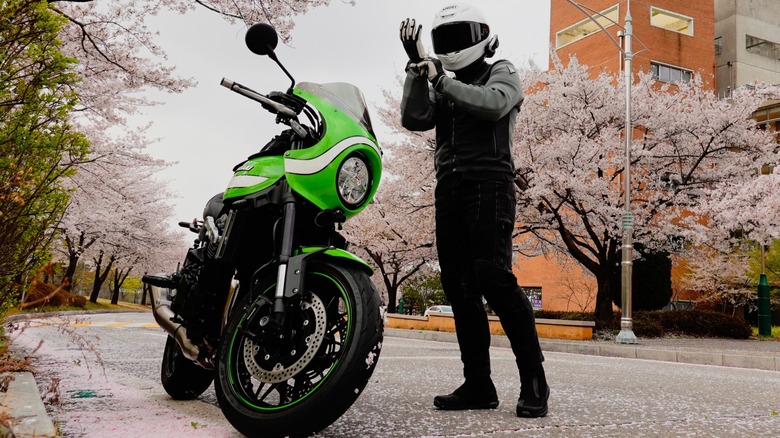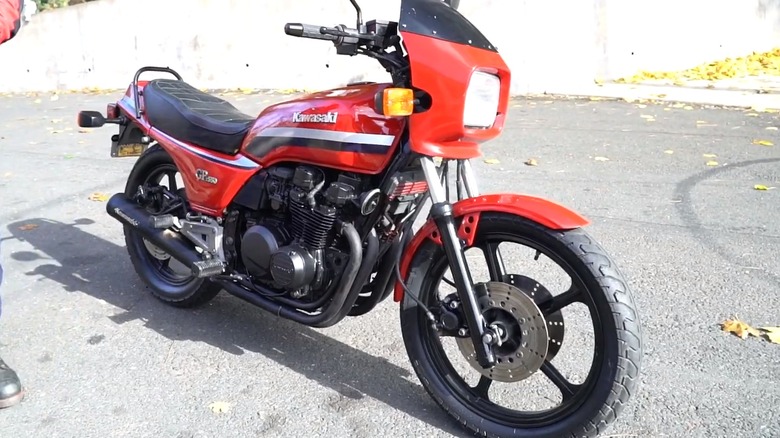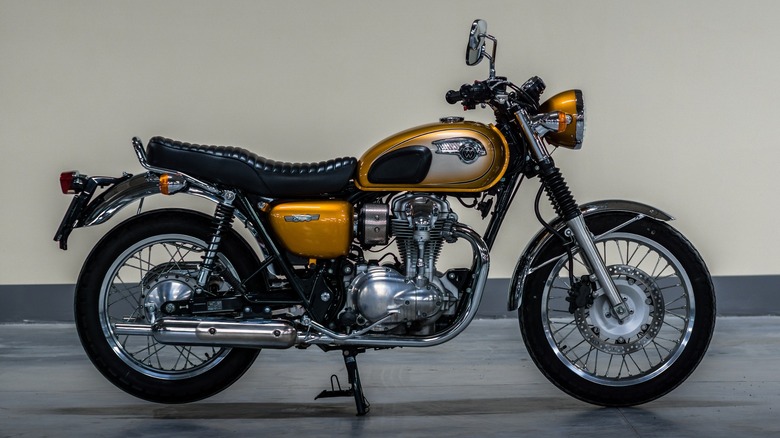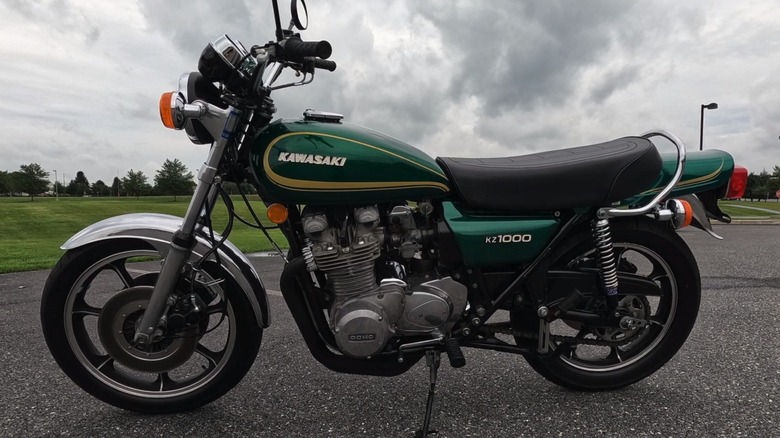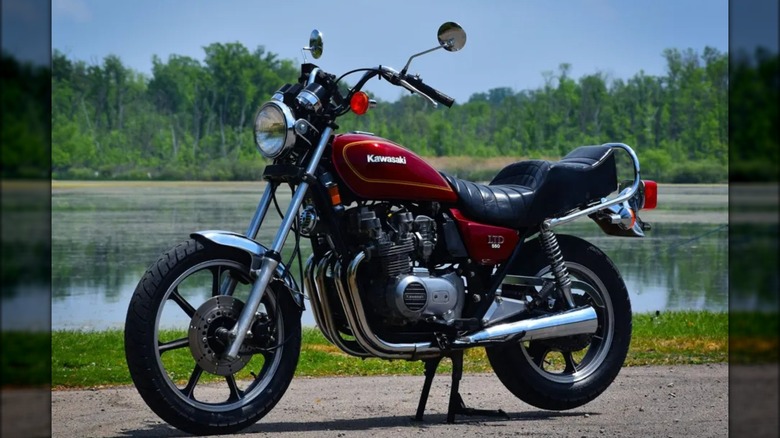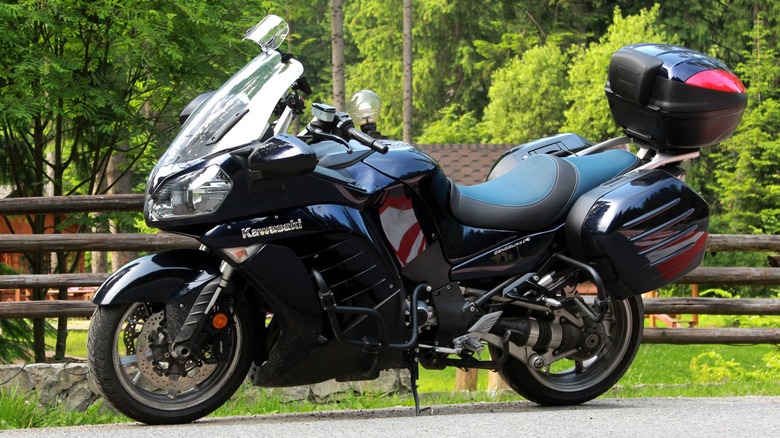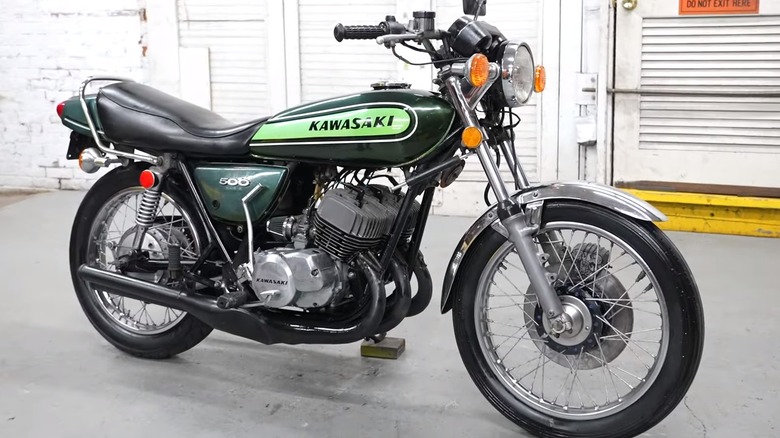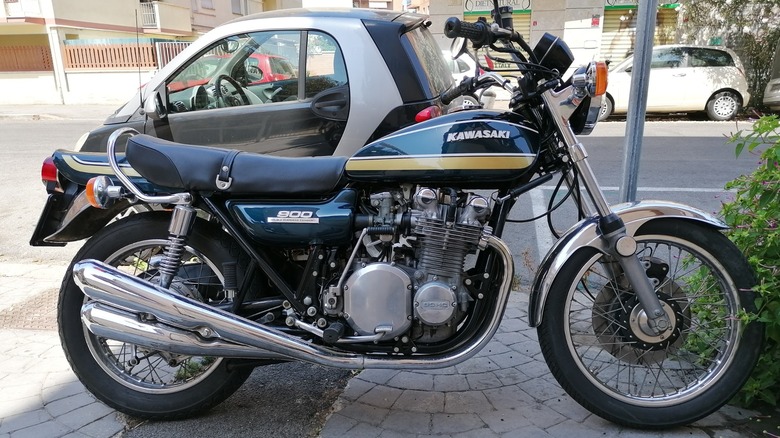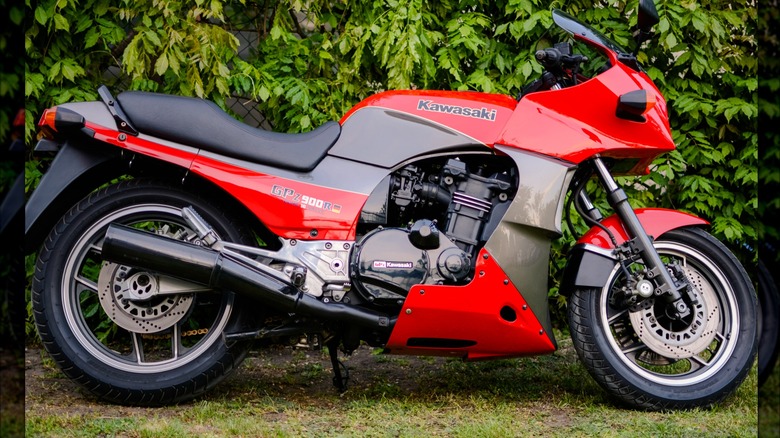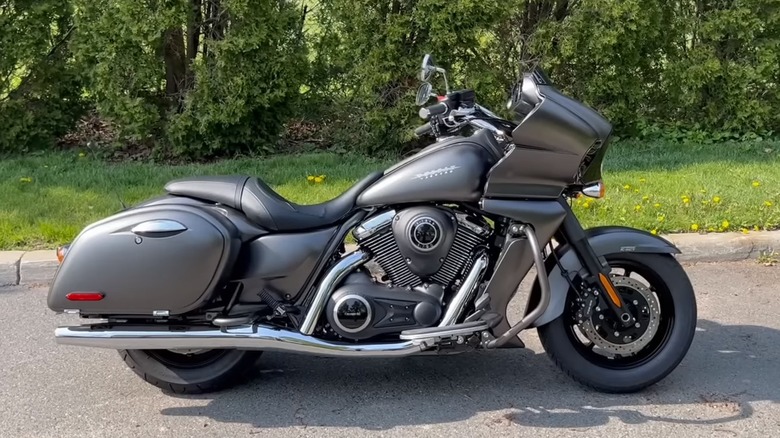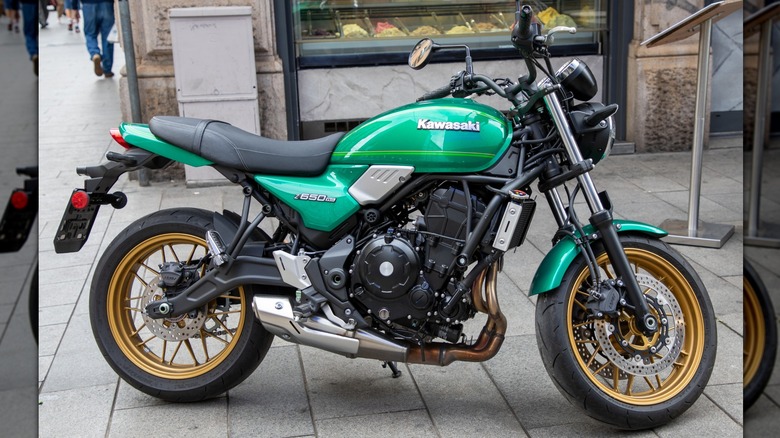10 Of The Most Eye-Catching Kawasaki Motorcycles In History
Although the manufacturing company known as Kawasaki has origins in the Victorian era, its production of two-wheeled machines came much later. Motorcycle engine manufacturing began in 1953 with the KE1, but not until 1962 did a motorcycle wear the company's badge, the Kawasaki 125cc B8, which used engineering first perfected in the company's aircraft from before WWII. Since then, the company has produced a wide range of motorcycles while establishing itself as an innovator and leader in the field.
Kawasaki's home is in Tokyo, Japan, but it has operations worldwide with manufacturing operations both in Japan and abroad. From these many facilities have come machines of all stripes to cater to the needs and desires of riders on and off the road, with many of them pushing the boundaries of performance and handling. Kawasaki bikes over the years have never been short on style, with many of its models setting trends that influenced the industry at large. With dozens of models released over the last 60 years, choosing the most stylish among them may not be the most straightforward task, but these bikes are the most eye-catching of them all.
Kawasaki GPZ 550/750/1100
While sophisticated and powerful sportbikes are a common sight on the streets today, that has not always been the case. Manufacturers worked to discover what worked for street bikes throughout the '60s and '70s. But at the dawn of the '80s, new designs with advanced engineering emerged to set the stage for the sportbike showdown that would occur in the ensuing years. Kawasaki's contribution to what would become one of the most popular segments in the market came as the GPZ in 1981 through 1983, available with engine sizes of 550, 750, and 1,100 cc.
The GPZ line made a significant departure in terms of styling from what had dominated throughout the '70s. Most Asian machines from the 1970s bore similarities to each other in a style that has since been defined as the Universal Japanese Motorcycle (UJM), featuring chrome exhaust pipes, fenders and trim, and bright aluminum engine blocks for all to see. The GPZ eschewed all the bright work for matte black surfaces on all the exposed mechanicals with shiny red paint on the fenders, tank, and side panels. Furthermore, the GPZ introduced a small fairing as a precursor to the full body panels that adorn today's sportbikes.
This was the look of things to come and remains sporty and appealing today. Fortunately, performance went with the updated looks as Kawasaki managed to squeeze a bit more power from its well-tested air-cooled 4-cylinder engines before entering into the superbike era.
Kawasaki W800
Kawasaki in the 1950s wanted to expand its operations beyond simply making motorcycle engines to start building complete bikes. In making such a big transformation of the company, it needed guidance and received it when it acquired Meguro motorcycles, in operation since before WWII, in 1960, and folded those operations into its own soon after. The immediate result of this combination was the Kawasaki-Meguro K2, which became the Kawasaki W1 in 1965.
This was a consequential and pivotal model for the company, which is why Kawasaki chose to bring it back in the form of the thoroughly modern yet classically styled W800 for the 2019 model year. While this bike bears a striking resemblance to the brand's first genuinely competitive street bike, riders benefit from the advantages that 50 years of motorcycle development afford. It features a fuel-injected parallel twin producing 47 horsepower with the safety of anti-lock disc brakes to rein it in.
Despite having modern niceties, the W800 is a beautifully styled retro motorcycle. It apes the original so fully that it looks like a vintage bike from a distance, and it helps that the original was a looker to begin with. With so many retro styled machines turning out to be modern flops, it's pleasing to see how well Kawasaki has done with the W800.
Kawasaki KZ1000
In the mid-'70s, Kawasaki began offering a range of motorcycles all built around the same basic styling with similar setups for performance and handling. These motorcycles bearing the KZ prefix ranged from 200 to 1,300cc in the years from 1976 through 1984, although the KZ1000-based Police 1000 survived until 2005. Among all of these models, the KZ1000 might be the most popular and has since become an icon of its time.
When it debuted, the KZ1000 was proclaimed by Cycle World to be the "quickest production bike we've tested" and "King of the Superbikes," which is high praise indeed. Having already established itself with its powerful and groundbreaking Z1, Kawasaki upped the ante with its successor by improving on everything that worked. It received more power, better handling, and smoother styling.
Kawasaki's styling of the KZ lineup followed the trend of the UJM, establishing them as desirable motorcycles distinct from European and American machines that came with the added benefit of legendary Japanese reliability. Although a KZ1000 may look a bit antiquated compared to modern offerings, it remains a desirable machine for those who appreciate a bike without superfluous styling and added flair for no reason. It is just a bike, and that is a beautiful thing.
Kawasaki LTD 550
Alongside Kawasaki's popular KZ models introduced in the late '70s were its companion LTD series of bikes. Built on the same frames and with the same engines, the LTD showed Kawasaki's recognition of the popularity of the American cruiser market and began making bikes that aped the classic American v-twins without going overboard.
Introduced in 1980, the LTD 550 introduced a middleweight-cruiser-inspired motorcycle that was capable across many fronts. As a relatively lightweight machine, it was easy to ride while offering good handling for its day. The experience would not overcome a novice rider while being substantial enough for a seasoned pro. Furthermore, the air-cooled 553cc 4-cylinder provided plenty of power for the most spirited of highway drives and punch to dart through traffic with ease.
The design of the bike is a bit of a dichotomy as its swept-back handlebars, semi-teardrop gas tank, and dual-level saddle provided a bit of a cruiser look while its mostly upright riding position sitting high on the frame kept the riding style of the UJM popular at the time. Today, these bikes are relatively affordable — a pristine example last sold on Bring a Trailer for $2,200 — without being so scarce as to be unobtainable, and they make great classic bikes to own for those wanting to keep expenses down. Plus, they still look great.
Kawasaki 1400GTR / Concours 14
The recently discontinued Concours line of motorcycles was a great option for those who doing serious touring on two wheels. With Kawasaki having moved well away from the bikes it built in the '70s and '80s, the modern Concours, introduced for the 2008 model year as a wholly redesigned update of the 1986 to 2006 Concours ZG1000, is the epitome of luxury on two wheels.
Touring bikes often act as a showcase of technological development for a manufacturer, and the Kawasaki Concours is no different. Furthermore, touring bikes are different from other bikes – riders tend to use them for extra long rides. If you are going to build a bike with the best and latest features for safety, comfort, and performance, the touring bike is the ideal choice, including the Concours. Upon its debut, standard features included an electrically adjustable windscreen, dual headlights, an adjustable rear shock, and a powerful fuel-injected engine.
By the end of its run in 2022, the Concours 14 had remained largely unchanged stylistically. It gained anti-lock brakes, keyless ignition, and variable valve timing, but appearance alterations were kept to a minimum, which is not a bad thing as it already possessed grateful and modern lines from end to end. Most riders of the Concours 14 likely appreciate it for being a sophisticated and modern bike made for tackling a mountain pass over something made for showing off with shiny accessories on the main drag. It's a bike built to ride.
Kawasaki Mach III H1 500
While environmental regulations led to two-stroke engines disappearing from motocross, they dominated on dirt bike tracks and trails until very recently. However, buzzy two-bangers once roamed freely roamed the streets and weren't always limited to mopeds and minibikes. Just as Japanese motorcycles were carving out a larger section of the late 1960s American market, Kawasaki released the Mach III H1 500, also affectionately called "The Widowmaker."
The Mach III debuted in 1959 featuring a brand-new engine from the company that boasted having three cylinders, 60 horsepower, and only two cycles. Mounted to a modestly sized frame and adorned with simply styled adornments, the unassuming and lightweight Kawasaki opened up a terror on the streets and tracks that proved to be a menace to rider and bystander alike.
While the looks of this bike are not particularly outstanding compared to its contemporaries, the sound of that two-stroke triple is something to behold. It provides an aural aesthetic as pleasing to the ears to most seasoned riders as a Mozart symphony is to a cellist. Furthermore, the power unleashed above 5,000 rpm is something that could take even experienced riders off guard and send bikes and riders sailing over any barrier ahead. The H1 was Kawasaki's first blisteringly fast bikes and helped establish the brand as a purveyor of power.
Kawasaki Z1
While Kawasaki led the performance field with its two-stroke Mach III in 1969, it kept up the pace with a 750 triple in 1972. But in development at the same time and also released in 1972 was a more mature and sophisticated model that set the motorcycle market on fire when it arrived, the 900cc four-stroke four-cylinder Kawasaki Z1, now a legend.
Honda released its CB750 in 1968, ushering in a new era of four-cylinder bikes from Japan dominating the field. While Kawasaki had a 750 inline-4 in the works, the CB750 caused a rethink and Kawasaki engineers went back to the drawing table, emerging with Z1 in 1972, taking the crown from Honda for having the fastest bike on the market. With the Kawasaki Z1, an important piece of Japanese motorcycle history had been established.
The Z1 was a crowning achievement of engineering and style for its day. Its engine overcame the competition with a 167cc displacement advantage and twice the overhead camshafts — Honda's first dual-cam engine came in 1979. Furthermore, it was a beautiful bike benefitting from symmetrical chrome exhaust pipes flowing down and back into dual split horns on either side, and the gently sloping gas tank leading to the turned up fender on the tail added some mildly seductive curves. It was otherwise a typical UJM that epitomized bikes of the day from Japan and also came with an incredible power-to-weight ratio that made it faster than anything around.
Kawasaki Ninja
To rank any one model of Ninja from its introduction in 1984 until today as the most attractive or eye-catching makes for a difficult task. Therefore, all of them will be included. After Kawasaki found success with its GPZ models, the company chose to focus on one in particular to add some clever bodywork and even more clever engineering to create Kawasaki's first superbike.
Kawasaki GPz900R designated this first superbike, and it represented a shift in the direction of high-performance motorcycle design from the company. Ninja introduced the first ever 16-valve twin-cam water-cooled inline-4 on a motorcycle, and its impact was felt across the industry. Since its debut, Kawasaki Ninja has been among the most recognizable and famous motorcycles ever made. Moreover, it spawned a long list of successors with increasingly more power and better handling, including the current model.
All Ninja motorcycles are striking in their appearance. Some of the highlights over the years include the 1989 ZX-7, 2006 ZX-14, and the current master Ninja H2 R, powered by a supercharged 1,000cc inline-4 delivering an astonishing 326 horsepower at a cost of $58,100. With seating only for one, a single swingarm, and a pair of giant front discs to slow it down, it looks like something either from the future or a far-off world. No matter which Ninja you choose, you will have a ride guaranteed to turn some heads.
Kawasaki Vulcan
While Kawasaki first dipped its toes into cruiser waters with its LTD motorcycles in the '70s and '80s, it went whole hog with the concept when it introduced the Vulcan line in 1985. Although it followed in the American v-twin styling tradition, it departed from that tradition with its relatively small 700cc v-twin with advanced features such as dual overhead cams and water cooling. Nevertheless, the Vulcan line pressed on and grew up along the way.
The Vulcan grew up to the point that Kawasaki offered a 2.0-liter v-twin model starting in 2004. While its engine has slimmed down a bit to 1.7 liters, the current Kawasaki Vulcan Vaquero is a stunning mass of mechanics and style. Taking its cues from the American bagger tradition, the Vaquero definitely looks more like something from Milwaukee than Tokyo. That's just fine because it doesn't need to fit in Tokyo, as this machine is built for the wide-open highways of North America.
Kawasaki is a capable company building highly technical motorcycles as it has done for years, but its Vulcan is less refined and even a bit long in the tooth, having been on the market since 2018. However, it doesn't matter because this bike is made for getting out on the road in style, and it's plenty capable of that. It comes with everything you need, including tunes with Bluetooth connection, and nothing you don't. It's a fabulous looking big machine, and it doesn't need to be anything else.
Kawasaki Z900RS
Kawasaki is proud of its heritage in building some of the most influential and powerful bikes through the years, and its past success shows just cause for that. Additionally, the styling of some of its past models never seems to go out of fashion, with certain elements continuing to pop up in new models all the time. In taking that notion to its full conclusion, Kawasaki released in 2018 the Z900RS as an homage to its trailblazing 900cc Z1 from 1972.
While the Z900RS is a thoroughly modern machine, it is built with the UJM styling at the fore and eliminates much of the extra body cladding that tends to overcome many modern motorcycles. This leaves this bike sitting naked with not much more than its headlight, engine, seat, and wheels to get excited about, and yet, that's plenty to be excited about.
To be clear, the Z900RS is no clone of the Z1. It has a radiator up front for the water-cooled and fuel-injected engine, and the exhaust pipes all into one muffler rather than the quad horns of the original. Yet, it retains the essence of the original bike and Kawasaki produces it with some of the original color schemes, blending perfectly the old and the new. For those who pine for the earlier days of motorcycling but prefer the convenience and reliability of the current day, this Kawasaki is the perfect choice and a fine looking one to boot.
